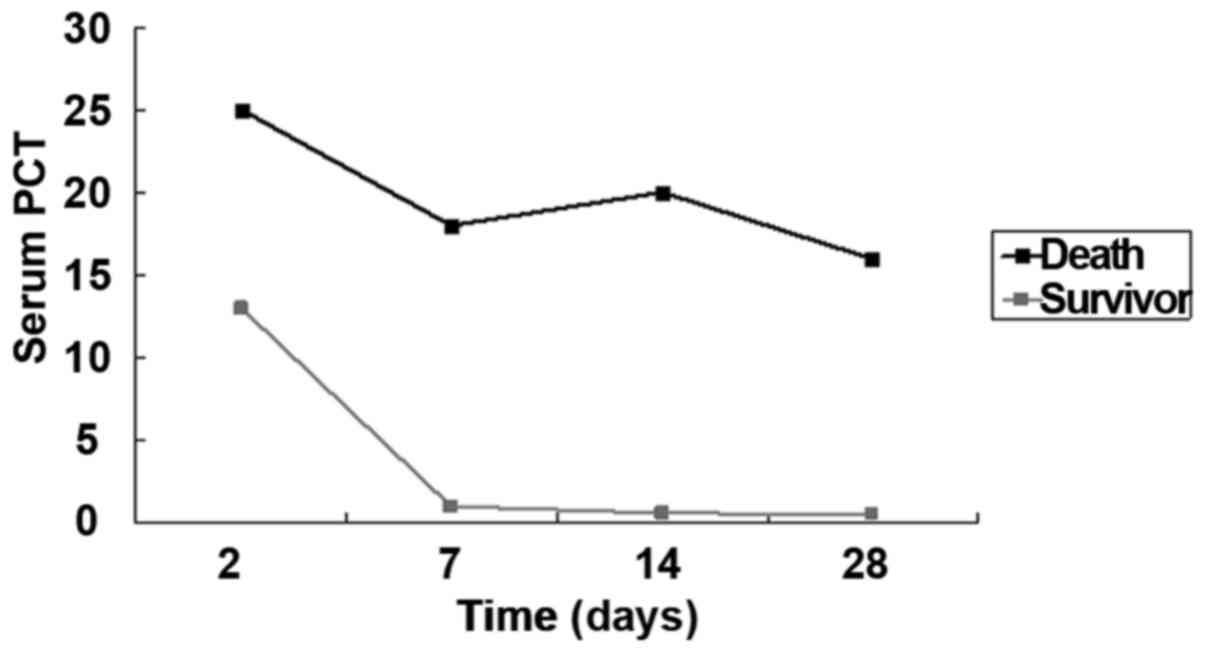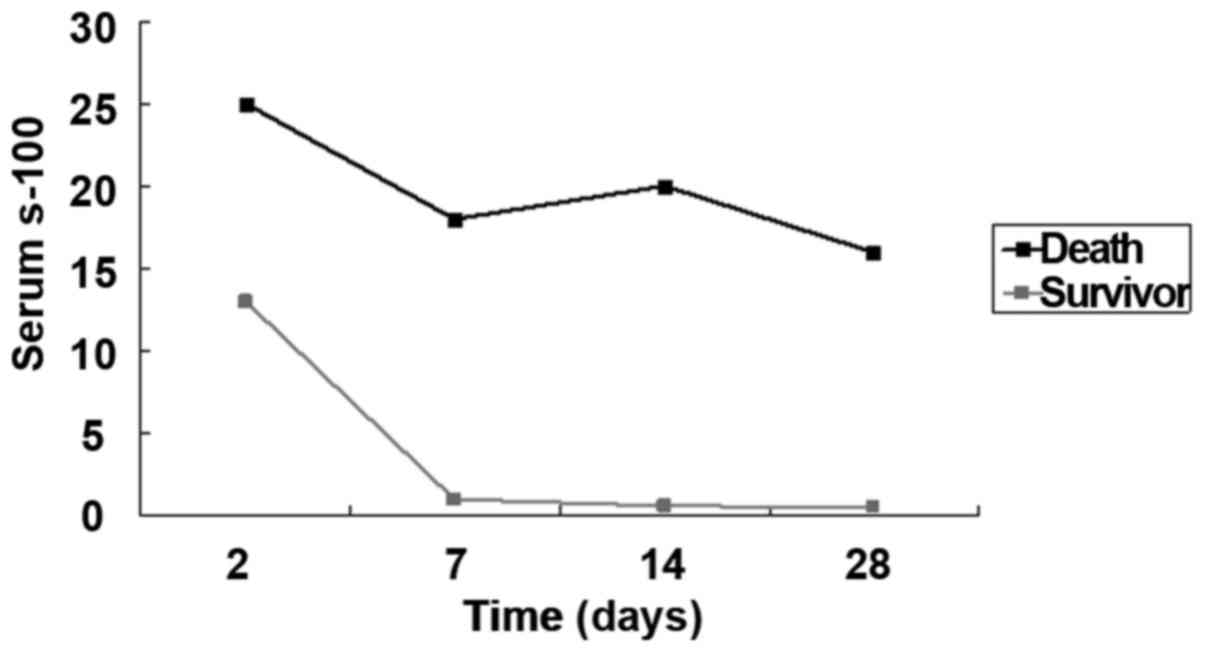|
1
|
Assicot M, Gendrel D, Carsin H, Raymond J,
Guilbaud J and Bohuon C: High serum procalcitonin concentrations in
patients with sepsis and infection. Lancet. 341:515–518. 1993.
View Article : Google Scholar : PubMed/NCBI
|
|
2
|
Nylen ES, Whang KT, Snider RH Jr,
Steinwald PM, White JC and Becker KL: Mortality is increased by
procalcitonin and decreased by an antiserum reactive to
procalcitonin in experimental sepsis. Crit Care Med. 26:1001–1006.
1998. View Article : Google Scholar : PubMed/NCBI
|
|
3
|
Whang KT, Vath SD, Becker KL, Snider RH,
Nylen ES, Muller B, Li Q, Tamarkin L and White JC: Procalcitqnin
and proinflammatory cytokine interaction in sepsis. Shock.
11:73–78. 2000. View Article : Google Scholar
|
|
4
|
Barati M, Alinejad F, Bahar MA, Tabrisi
MS, Shamshiri AR, Bodouhi NO and Karimi H: Comparison of WBC ESR,
CRP and PCT serum levels in septic and non-septic burn cases.
Burns. 34:770–774. 2008. View Article : Google Scholar : PubMed/NCBI
|
|
5
|
Alkholi UM, Abd Al-Monem N, Abd El-Azim AA
and Sultan MH: Serum procalcitonin in viral and bacterial
meningitis. J Glob Infect Dis. 3:14–18. 2011. View Article : Google Scholar : PubMed/NCBI
|
|
6
|
Viallon A, Guyomarc'h P, Guyomarc'h S,
Tardy B, Robert F, Marjollet O, Caricajo A, Lambert C, Zéni F and
Bertrand JC: Decrease in serum procalcitonin levels over time
during treatment of acute bacterial meningitis. Crit Care.
9:R344–R350. 2005. View
Article : Google Scholar : PubMed/NCBI
|
|
7
|
Jereb M, Muzlovic I, Hojker S and Strle F:
Predictive value of serum and cerebrospinal fluid procalcitonin
levels for the diagnosis of bacterial meningitis. Infection.
29:209–212. 2001. View Article : Google Scholar : PubMed/NCBI
|
|
8
|
Lorrot M, Moulin F, Coste J, Ravilly S,
Guérin S, Lebon P, Lacombe C, Raymond J, Bohuon C and Gendrel D:
Procalcitonin in pediatric emergencies: Comparison with C-reactive
protein, interleukin-6 and interferon alpha in the differentiation
between bacterial and viral infections. Presse Med. 29:128–134.
2000.(In French). PubMed/NCBI
|
|
9
|
Knudsen TB, Larsen K, Kristiansen TB,
Møller HJ, Tvede M, Eugen-Olsen J and Kronborg G: Diagnostic value
of soluble CD163 serum levels in patients suspected of meningitis:
Comparison with CRP and procalcitonin. Scand J Infect Dis.
39:542–553. 2007. View Article : Google Scholar : PubMed/NCBI
|
|
10
|
Taskin E, Turgut M, Kilic M, Akbulut H and
Aygun AD: Serum procalcitonin and cerebrospinal fluid cytokines
level in children with meningitis. Mediators Inflamm. 13:269–273.
2004. View Article : Google Scholar : PubMed/NCBI
|
|
11
|
Kang YA, Kwon SY, Yoon HI, Lee JH and Lee
CT: Role of C-reactive protein and procalcitonin in differentiation
of tuberculosis from bacterial community acquired pneumonia. Korean
J Intern Med. 24:337–342. 2009. View Article : Google Scholar : PubMed/NCBI
|
|
12
|
Jiang J, Shi HZ, Liang QL, Qin SM and Qin
XJ: Diagnostic value of interferon-gamma in tuberculous pleurisy: A
metaanalysis. Chest. 131:1133–1141. 2007. View Article : Google Scholar : PubMed/NCBI
|
|
13
|
Carrol ED, Newland P, Thomson AP and Hart
CA: Prognostic value of procalcitonin in children with
meningococcal sepsis. Crit Care Med. 33:224–225. 2005. View Article : Google Scholar : PubMed/NCBI
|
|
14
|
Stich O, Andres TA, Gross CM, Gerber SI,
Rauer S and Langosch JM: An observational study of inflammation in
the central nervous system in patients with bipolar disorder.
Bipolar Disord. 17:291–302. 2015. View Article : Google Scholar : PubMed/NCBI
|
|
15
|
Petros S, Leonhardt U and Engelmann L:
Serum procalcitonin and proinflammatory cytokines in a patient with
acute severe leptospirosis. Scand J Infect Dis. 32:104–105. 2000.
View Article : Google Scholar : PubMed/NCBI
|
|
16
|
Mills GD, Lala HM, Oehley MR, Craig AB,
Barratt K, Hood D, Thornley CN, Nesdale A, Manikkam NE and Reeve P:
Elevated procalcitonin as a diagnostic marker in meningococcal
disease. Eur J Clin Microbiol Infect Dis. 25:501–509. 2006.
View Article : Google Scholar : PubMed/NCBI
|
|
17
|
Christ-Crain M, Jaccard-Stolz D, Bingisser
R, Gencay MM, Huber PR, Tamm M and Müller B: Effect of
procalcitonin-guided treatment on antibiotic use and outcome in
lower respiratory tract infections: Cluster-randomised,
single-blinded intervention trial. Lancet. 363:600–607. 2004.
View Article : Google Scholar : PubMed/NCBI
|
|
18
|
Viallon A, Pouze V, Zéni F, Tardy B,
Guyomarc'h S, Lambert C, Page Y and Bertrand JC: Rapid diagnosis of
the type of meningitis (bacterial or viral) by the assay of serum
procalcitionin. Presse Med. 29:584–588. 2000.(In French).
PubMed/NCBI
|
|
19
|
Dubos F, Korczowski B, Aygun DA, Martinot
A, Prat C, Galetto-Lacour A, Casado-Flores J, Taskin E, Leclerc F,
Rodrigo C, et al: Distinguishing between bacterial and aseptic
meningitis in children: European comparison of two clinical
decision rules. Arch Dis Child. 95:963–967. 2010. View Article : Google Scholar : PubMed/NCBI
|
















